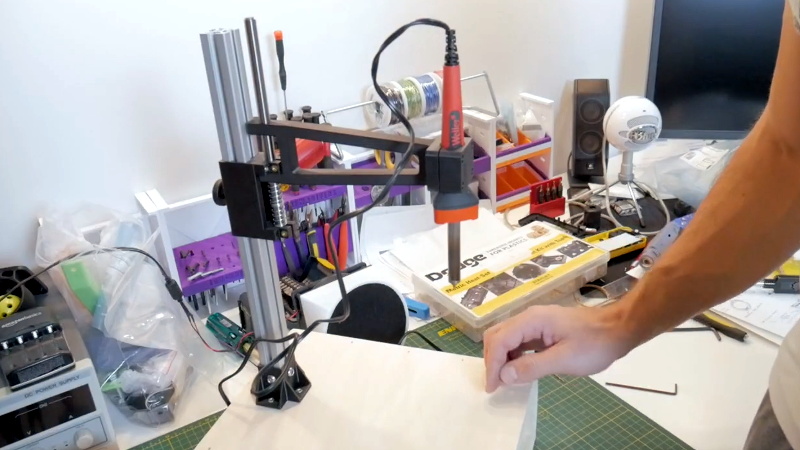If you’re building mechanical assemblies with 3D printed parts, you’ll quickly realize that driving machine screws into thermoplastic isn’t exactly an ideal solution. It can work in a pinch, but you can easily strip the threads if you crank down too hard. The plastic holes can also get worn down from repeated use, which is a problem if you’re working on something that needs to be taken apart and reassembled frequently. In those situations, using brass heat set inserts gives the fasteners something stronger to bite into.
You can install these inserts by hand, but if you plan on doing a lot of them, a dedicated press station like the one [Chris Chimienti] recently put together will save you a lot of aggravation in the long run. In the video after the break he walks viewers through the design and use of the device, which itself relies on a number of 3D printed parts using the very same inserts it’s designed to install.

To build this tool you’ll need a piece of aluminum extrusion, some smooth rod, a couple springs, and an assortment of fasteners. Nothing that wouldn’t likely be in the parts bin of anyone who’s been tinkering with 3D printers for awhile, though even if you had to buy everything, the Bill of Materials will hardly break the bank. For the base you can use a piece of scrap wood, though [Chris] has opted to make it a storage compartment where he can store the inserts themselves. We really like this approach, but obviously you’ll need to have access to woodworking tools in that case.
Clearly shopping on the top shelf, [Chris] purchased a kit that actually came with a Weller soldering iron and the appropriate tips for the various sized inserts. If you’re like us and just buy the inserts that come in a plastic baggie, you may need to adapt the arm to fit your iron of choice. That said, the idea of having a dedicated iron that you can leave mounted in the press makes a lot of sense to us if you can swing it.
[Joshua Vasquez] wrote up a phenomenal guide to getting started with heat set inserts last year that’s an absolute must-read for anyone interested in the concept. Whether you build a dedicated press or just push them in freehand, his tips and tricks will help insure you get the best result possible.
















I hate to be the grammar nazi here (not really :P ) but
“which is a problem if _your_ working on something that needs to be taken apart”
What an incredibly boring life you must have.
How mediocre yours must be :P
I cant imagine how one can do a mistake like that…
That sentence in the article looks correct to me, so I hope you’re not trying to convince the author to use the wrong word. After all, your post doesn’t show the correct word to use. Also, given the lack of commas and periods in your post, is it safe to say you hate to be a punctuation Nazi? ;)
If you’re going to be attempting to correct someone and claim to be a grammar nazi, at the very least ensure your correction is actually correct. “Which is a problem if you are working on something”. You are -> You’re. Not your.
Grammar, the difference between knowing your shit and knowing you’re shit.
The headline begs the question, who builds unaffordable projects?
Define affordable – I frequently start projects that take much longer to finish than I’d like because the money ran out again (or sometimes get dropped entirely if the early stages make it look too pricey)….So you could argue they are unaffordable, even if they are not that expensive…
That said I’d guess anything around the £70 sort of mark AAA games are apparently now going to be is probably a good benchmark for ‘affordable project’ – the project probably lasts longer and brings greater satisfaction…
Have you really never had a project spiral wildly out of budget? Seems like half the stuff I build costs 2 – 3x what I estimate, often more than what a commercial version would have run me.
Something that you can build with printed parts and stuff from your box of parts hopefully avoids this problem.
I’d rather make an adapted soldering iron sothat it can fit in the chuck of a srandard drill press.
Indeed: https://github.com/macdroid53/Soldering-iron-adapter